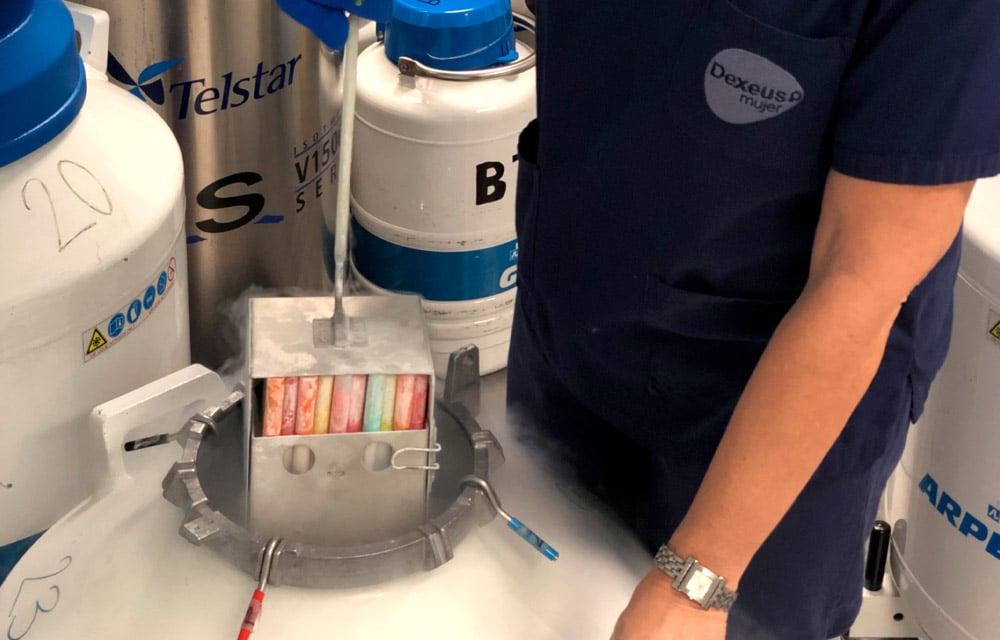If you have frozen embryos, surely you would like to be able to watch through a peephole how they are being looked after in the laboratory: where they are being kept, how they are being handled, what systems are being used to identify and preserve them, or how they will be thawed when the time comes to use them. It is only natural. Your embryos are the result of a lot of work and effort, not to mention all the hopes and expectations you place in them.
Furthermore, embryos are an extremely sensitive biological material. Taking care of something so valuable is, therefore, a great responsibility. Embryologists are aware of this, and in fact they establish shifts in cryopreservation laboratories, as doctors do in hospitals, so that on weekends and public holidays there is always someone “taking care of them.”
At our fertility centre, moreover, we have an automated system that permanently monitors —24 hours a day, 365 days a year— the conditions of the cryogenic tanks and the room where they are located, so they are as well guarded as the most precious paintings in the Louvre Museum, and that is no joke. So, you can rest assured!
If you want to know more, in this post, Miquel Solé, head of the Cryopreservation Laboratory at Dexeus Mujer, explains a few interesting facts.
How big is an embryo and how much room does it need?
An embryo requires a very, very tiny space. It measures less than 1 mm in diameter, and it cannot survive more than 7 days in culture, which is why embryos must be frozen in order to preserve them. Cryopreservation is a process of cooling and storing cells, tissues, or organs at very low temperatures in order to preserve them for future use.
How are they handled?
After cryopreservation, embryos are not manipulated. They are stored in a cryogenic tank until the time comes to use them.
Is it dangerous to freeze them?
No. Although it may seem overly complex, with the techniques currently used, most cryopreserved embryos survive thawing (>95 %) and remain viable as if they had not undergone this process.
How are they frozen?
Embryos are frozen using an ultra-fast technique called vitrification. They are exposed to a cryoprotective solution that protects them from the drop in temperature, preventing the formation of ice. After this preliminary step, the embryos are directly immersed in liquid nitrogen.
Where are they stored?
After being immersed in liquid nitrogen, the supports with the cryopreserved embryos are placed inside an elongated cylindrical tube that will be “their home” while they are kept frozen. These cylinders containing the embryos are called straws and are placed in a predetermined location inside circular steel containers immersed in liquid nitrogen, to maintain the embryos at temperatures below –180 °C. Each of these containers holds thousands of embryos —up to 10,000 embryos!
Do embryos have “their own room”, like in a hotel?
Yes, nitrogen tanks have several compartments, and each straw is placed in a specific place, as if the embryos had their own private parking space. This way it is very easy to locate them. When the embryos are placed in the tank, two biologists check their new location.
Are all the “sibling” embryos together?
Yes, they are always placed together, which makes it easier to locate them when needed.
How is embryo information registered to avoid errors?
The straws are identified with the name and surname of the patient, as well as with a bar code that identifies the patient and indicates the corresponding IVF cycle. In addition, the location of the different embryos is stored in two different digital sources, for greater security.
While they are frozen, can embryos be said to be “asleep”?
Actually, rather than causing lethargy, vitrification inactivates them. They remain in a state that prevents their development and also prevents them from deteriorating. It is as if time stopped for them.
How long can they be kept frozen?
They can be kept for many years. In fact, embryos that have been vitrified for more than 10 years have been thawed and have resulted in pregnancies and the birth of completely healthy babies. To date, it has not been possible to determine a time limit for how long they can remain cryopreserved for later use.
What if something goes wrong, how do you detect it?
At Dexeus Mujer we have a control system that allows nitrogen tanks to be filled automatically. In addition, in the event of any error or deviation from the set parameters —pressure, temperature, etc.— alarms are generated and sent immediately to the different laboratory managers and to the hospital’s Security Department. These alarms do not stop sending messages to the recipients until the error is resolved.
How do you act in these cases?
A biologist must always be available and check regularly on the state of the Cryogenic Room so that s/he can go to the fertility centre in the event of any abnormal situation, with enough margin of time to ensure there is no change in the storage conditions of the embryos.
How are they thawed for transfer?
To thaw the embryos, the reverse process of vitrification is carried out: they are directly submerged in a solution at 37 °C and then submerged in other solutions that facilitate their rehydration. After a few minutes in these solutions, the embryos are cultured again in an incubator until they are transferred to the maternal uterus.














